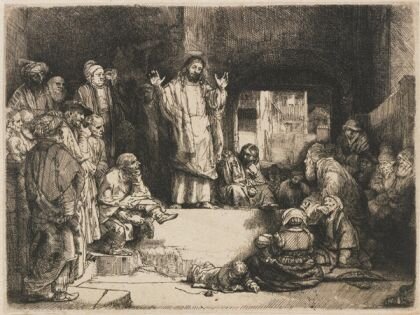Edward Elgar - The Apostles - A Study Guide
[Written by Thomas Lloyd, Artistic Director, Bucks County Choral Society; all rights reserved.]
PART I
PROLOGUE
Rembrandt’s depiction of Jesus preaching of the “gospel to the poor.”
The Prologue for orchestra before the first choral entrance creates an atmosphere of mystical solemnity that permeates the entire work. This is also perhaps the best-known section because of its use as a choral anthem in many churches over the years. The text is the passage from the prophet Isaiah used by Jesus to proclaim his primary mission to the poor at the beginning of his public ministry (a theme also central to Elgar’s personal understanding of his faith and social standing).
Listen to this section all the way through, following the text closely. A composer could choose to set this familiar text any number of ways. Even though the words are those of an individual, the prophet Isaiah as proclaimed by Jesus, Elgar chooses to have them sung by a chorus of many voices, over a rich and evocative orchestral palette. Where is Elgar taking us? What aspects of Christ’s persona and mission does he want us to be most affected by before beginning the story?
Watch the video from the opening to 7:29
The spirit of the Lord is upon me,
because he hath anointed me to preach the gospel to the poor;
he hath sent me to heal the broken-hearted,
to preach deliverance to the captives,
and recovering of sight to the blind –
to preach the acceptable year of the Lord; (Luke 4:18)
To give unto them that mourn a garland for ashes,
the oil of joy for mourning,
the garment of praise for the spirit of heaviness;
that they might be called the trees of righteousness,
the planting of the Lord,
that He might be glorified. (Is. 61:3)
For as the earth bringeth forth her bud,
and as the garden that causeth the things that are sown in it to spring forth,
so the Lord God will cause righteousness and praise to spring forth
before all the nations. (Is. 61:11)
The Spirit of the Lord is upon me,
because He hath anointed me to preach the Gospel. (Luke 4:18)
Now that you’ve listened straight through, focus on several of the important themes introduced here that will return later at important points in the oratorio, as defined by Elgar’s publisher and close friend A. J. Jaeger (the “Nimrod” of the Enigma Variations) under the composer’s supervision:
The “Spirit of the Lord” theme played by the orchestra at the very beginning (a 'Trinitarian' three times before the choir enters). The gesture might suggest a posture of kneeling down to pray while lifting the arms toward heaven. But it also contains an element of uncertainty, and of longing:
“Christ the Man of Sorrows” theme - a strange harmonic progression unexpected in the middle of the straightforward melody around it, for the words “hath appointed me”:
“Christ’s Mission” theme - the vocal melody for the words “He hath sent me to heal the brokenhearted” with the strings playing the “Gospel” motif under the words “brokenhearted”:
“Light of Life” theme - a melody Elgar quotes from his own earlier cantata Light of Life for the words “and recov'ring of sight to the blind”:
“Comfort” theme - a melody sung to the words “To give unto them that mourn a garland for ashes” always accompanied by a narrowly rising scale in the orchestra underneath:
“The Church” theme - a soaring new melody heard first in the sopranos for the words “For as the earth bringeth forth her bud”:
And finally, the Prologue ends with a statement of the “Divine Christ” theme in the orchestra, melding with the “Spirit of the Lord” theme from the opening, and then a restatement by the choir of the “Spirit of the Lord” text.
Christ the Son of God motif:
Questions to ponder:
How do these musical symbols set the stage for what is to follow?
What musical interpretation is Elgar suggesting for Christ’s mission and those of the apostles who would follow him?
This music was written in a time very different from ours in many ways. Does it still connect with your sensibilities listening over a century later? Does it seem strange in some ways? Does it evoke thoughts, feelings, or moods in unexpected ways?

